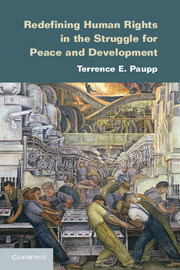Book contents
- Frontmatter
- Dedication
- Contents
- List of Tables
- Foreword
- Acknowledgments
- Introduction
- 1 The greatest undiagnosed problem in international law
- 2 From disparity to centrality: How the human rights to peace and development can be secured
- 3 Confronting structural injustice: Strategies of localization, regionalism, and an emerging global constitutional order
- 4 The power of law versus the law of power: How human rights can overcome inequality, poverty, and vested interests
- 5 A world community that includes all human communities: Indigenous communities and the global environment as sources for human rights claims
- 6 Actualizing the human right to peace: Paths for developing processes and creating conditions for peace
- Conclusion Transformation through cooperation: Implementing a human rights–based approach to human security
- Biography of Terrence E. Paupp
- Appendix 1 Principles Relating to the Status of National Institutions (The Paris Principles)
- Appendix 2 Tilburg Guiding Principles on World Bank, IMF, and Human Rights
- Appendix 3 Universal Declaration of the Rights of Peoples (Algiers, 4 July 1976)
- Appendix 4 The Freedom Charter (Africa, 1955)
- Index
- References
6 - Actualizing the human right to peace: Paths for developing processes and creating conditions for peace
Published online by Cambridge University Press: 05 June 2014
- Frontmatter
- Dedication
- Contents
- List of Tables
- Foreword
- Acknowledgments
- Introduction
- 1 The greatest undiagnosed problem in international law
- 2 From disparity to centrality: How the human rights to peace and development can be secured
- 3 Confronting structural injustice: Strategies of localization, regionalism, and an emerging global constitutional order
- 4 The power of law versus the law of power: How human rights can overcome inequality, poverty, and vested interests
- 5 A world community that includes all human communities: Indigenous communities and the global environment as sources for human rights claims
- 6 Actualizing the human right to peace: Paths for developing processes and creating conditions for peace
- Conclusion Transformation through cooperation: Implementing a human rights–based approach to human security
- Biography of Terrence E. Paupp
- Appendix 1 Principles Relating to the Status of National Institutions (The Paris Principles)
- Appendix 2 Tilburg Guiding Principles on World Bank, IMF, and Human Rights
- Appendix 3 Universal Declaration of the Rights of Peoples (Algiers, 4 July 1976)
- Appendix 4 The Freedom Charter (Africa, 1955)
- Index
- References
Summary
International relations in the twenty-first century can be war, conflict, or cooperation that emphasizes peace. If the century is dominated by conflict, it will be a terrifying time . . . Among international scholars there is support for a right of peace that should be accepted in international and local courts, or the right of exodus, which could be enforced against a warring state by citizens of that state against their respective government or the governments of other states. The right of peace would become part of the ensemble of rights that humanity now expects for itself, through legal, social, and political institutions and ultimately by its own actions. With a right of peace, the burden shifts away from citizens to blindly follow the call to war, for the nation would be constrained in its activities by those who opt out of the war system. A tragedy of our time is the moral disconnect between the individual’s conscience and the activities of government, which are encased in self-serving, moralistic rhetoric and in reality are governed by crude notions of power and domination. Once the right to peace is internationally recognized – with or without American acceptance in the early stages of affirmation by other nations – and such rights are further buttressed by personal accountability for war crimes, which include preparation for war as partially determined by the size of defense budgets and the nature of weaponry in an arsenal, there will be far greater weight given by governments to finding alternatives to the system of war as the fundamental way of protecting interests and settling disputes among nations or within nations
(Raskin 2004, 229–230).- Type
- Chapter
- Information
- Publisher: Cambridge University PressPrint publication year: 2014



